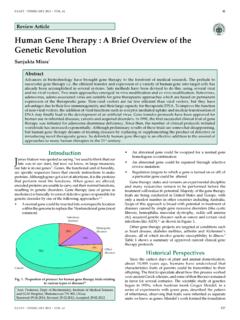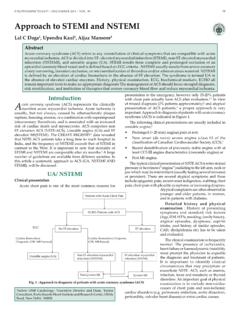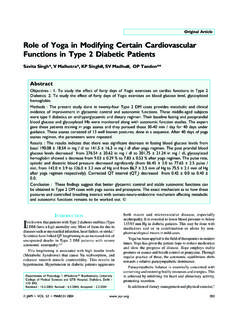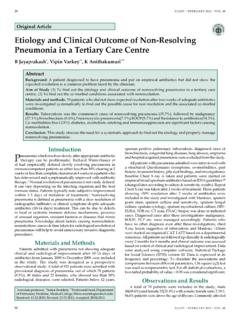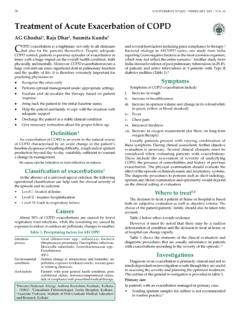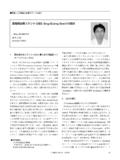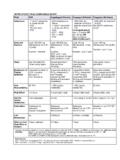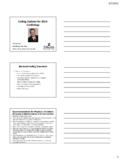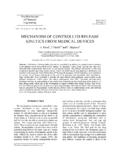Transcription of Guidelines for Management of Acute Myocardial …
1 SUPPLEMENT TO JAPI dEcEMbEr 2011 V O L . 59 37 Acute Myocardial infarction (AMI) can be defined from a number of different perspectives that pertain to clinical, electrocardiographic (ECG), biochemical and pathological characteristics. The Guidelines that will be mentioned in this article refer to patients presenting with symptoms of ischaemia and persistent ST-segment elevation on the ECG (STEMI).Initial Diagnosis and Early Risk StratificationRapid diagnosis and early risk stratification of patients presenting with Acute chest pain constitute the pillars of success in STEMI Management . An efficient regional system of care based on pre-hospital diagnosis, triage and rapid transportation to the best available facility holds the key to success of treatment and significantly improves outcome.
2 Initial Diagnosis of STEMI History of chest pain / discomfort lasting for 10-20 minutes or more (not responding to nitroglycerine) ECG : Persistent ST-segment elevation or (presumed) new left bundle-branch block. Repeated ECG recordings often needed since ECG can be equivocal in early hours Elevated markers of Myocardial necrosis (CK-MB, troponins) can be sometimes helpful in deciding to perform coronary angiography (eg. in LBBB) but one should not wait for the results to initiate reperfusion therapy 2D-echocardiography rules out major Myocardial ischaemia by demonstrating absence of wall motion abnormalities. Valuable in cases when diagnosis of STEMI is in doubt.
3 Older age, higher Killip class, elevated heart rate, lower systolic blood pressure and anterior location of the infarct are important factors in risk-stratification of STEMI patients. Other important predictors are previous infarction, height, time to treatment, diabetes and smoking Steps of Carei. Pain relief : Intravenous opioids (4 8mg morphine) with additional doses of 2 mg at 5 15 minutes intervals until pain is relieved. [Class I Level C recommendation].ii. Oxygen : 2 4 L/min by mask or nasal prongs should be administered to those who are breathless or who have any features of heart failure or Tranquilizer : It may be appropriate to administer a tranquilizer in very anxious for initial Management of Acute STEMI are based on most recent ACC/AHA Guidelines for Management of Patients with ST-Elevation Myocardial ,2,3 Guidelines for Management of Acute Myocardial InfarctionAmal Kumar Banerjee*, Soumitra Kumar**Senior Consultant & Intervention Cardiologist, AMRI Hospital, Salt Lake, Kolkata; Formerly, Cardiology Division, Institute of Cardiovascular Sciences, IPGEME&R, SSKM Hospital, Kolkata.
4 **Professor, Department of Medicine (Division of Cardiology), Vivekananda Institute of Medical Sciences, Kolkata; Chief Co-ordinator (Academic Services Cardiology), Rabindranath Tagore International Institute of Cardiac Sciences, KolkataTable 1 : Routine prophylactic therapies in the Acute phase of STEMIR ecommendationsClassLevelAspirin : Loading dose 150-300 mg followed by maintenance dose of 75-100 mgIAClopidogrel : Loading 300-600 mg; maintenance dose of 75mgIAPrasugrel : 60 mg loading followed by 10 mg maintenance for primary PCI IcNon-selective and selective COX-2 agents b-blockerIIabOral blockerIcACE-inhibitor : oral formulation on first day for all patients in whom it is not contraindicated for high-risk patientsIIaANitratesIIbACalcium antagonistsIIIbMagnesiumIIIAL idocaineIIIbGlucose-insulin-potassium infusionIIIbAbstractThese Guidelines summarize and evaluate all currently available evidence on Acute Myocardial Infarction (AMI) with the aim of assisting physicians in selecting the best Management strategies for a typical patient, suffering from AMI, taking into account the impact on outcome, as well as the risk/ benefit ratio of particular diagnostic or therapeutic means.
5 Rapid diagnosis and early risk stratification of patients presenting with AMI are important to identify patients in whom early interventions can improve outcome. AMI can be defined from a number of different perspectives related to clinical, electrocardiographic (ECG), biochemical, and pathological characteristics. Quantitative assessment of risk is useful for clinical decision patients with the clinical presentation of AMI within 12 h after symptom onset, early mechanical (PCI) or pharmacological reperfusion should be performed. Platelet activation and subsequent aggregation play a dominant role in the propagation of arterial thrombosis and consequently are the key therapeutic targets in the Management of AMI.
6 Adjunctive therapy with antiplatelets and antithrombotics is essential. A recommendation for routine urgent PCI ( within 24 h ) following successful fibrinolysis seems to be most practical option. In India, pharmaco-invasive therapy is the best option. 38 SUPPLEMENT TO JAPI dEcEMbEr 2011 VOL. 59 Recommendations by the Task Force on the Management of ST-segment elevation Acute Myocardial infarction of the European Society of cardiology4 for initial Management of Acute STEMI are similar and are enlisted in angiotensin receptor blocker (ARB) should be administered to STEMI patients who are intolerant of ACEIs and who have either clinical or radiological signs of heart failure or LVEF less than [IC].
7 Valsartan and candesartan have established efficacy for this Management : A fasting lipid profile (or obtaining one from recent past records for all STEMI patients) should be performed within 24 hours of symptom onset and lipid-lowering medication namely statins should be initiated before discharge [IA].Treatment goals for LDL-C after STEMI should be < 100 mg/dl [IA] and further reduction to < 70 mg/dl appears reasonable [IIa-A]. Dietary advice on discharge should be given to all STEMI patients especially emphasizing on < 7% of total calories from saturated fat and < 200 mg/day of cholesterol [IA]. For patients with non-HDL-C < 130 mg/dl and who also have HDL-C < 40 mg/dl, special emphasis should be given on life-style modification exercise, weight loss and smoking cessation [IB].
8 Drugs like niacin or fibrate to raise HDL-C in this situation have IIa recommendation (Level of evidence : B) after achieving LDL-C < 100 mg/dl with statins. However, if triglycerides are 500 mg/dl, niacin or fibrates should be initiated before LDL-lowering therapy in order to prevent pancreatitis [IC].Selection of Reperfusion Strategy A. In hospitals with PCI capability : A total of 23 published randomized controlled trials have compared primary PCI to fibrinolytic therapy in patients with STEMI. A meta-analysis reported the short and long-term outcomes of the 7,739 patients (3,872 randomized to primary PCI and 3,867 randomized to fibrinolytic therapy) enrolled in these In this analysis, primary PCI was superior to fibrinolytic therapy in reducing overall short-term death (7% vs.)
9 9%, p= ), nonfatal reinfarction (3% vs. 7%, p< ), stroke ( vs/ , p= ), and the combined endpoint of death, nonfatal reinfarction and stroke (8% vs. 14%, p< ).b. In hospitals without PCI capability. The ACC/AHA Guidelines suggest that four factors are to be considered when deciding whether to use fibrinolytic therapy or transfer the patient for primary PCI while a patient presents to a hospital without PCI capability. These are : i. Time from symptom onset ii. Clinical risk of STEMI iii. Risk of bleeding iv. Time required for transport to a PCI centreAnticipated prolonged transport delay to a PCI centre such that door-to-balloon time minus door-to-needle time is > 60 minutes.
10 However, in a recent analysis of sixteen randomized trials, Tarantini et al6 concluded that acceptable reperfusion delay to prefer primary angioplasty over fibrin-specific thrombolytic therapy is affected (mainly) by the patient s mortality risk 1 hour does not fit all. The acceptable PPCI-related delay (the time that nullifies the advantage of PPCI over thrombolytic therapy [TT]) is influenced by the baseline risk mortality and by the presentation delay, as illustrated by the following equation, obtained by the regression analysis : Z = - - (where Z is the absolute 30-days reduction in mortality of PPCI over TT, c the mortality risk, U the PPCI-related delay, and W the presentation delay).

